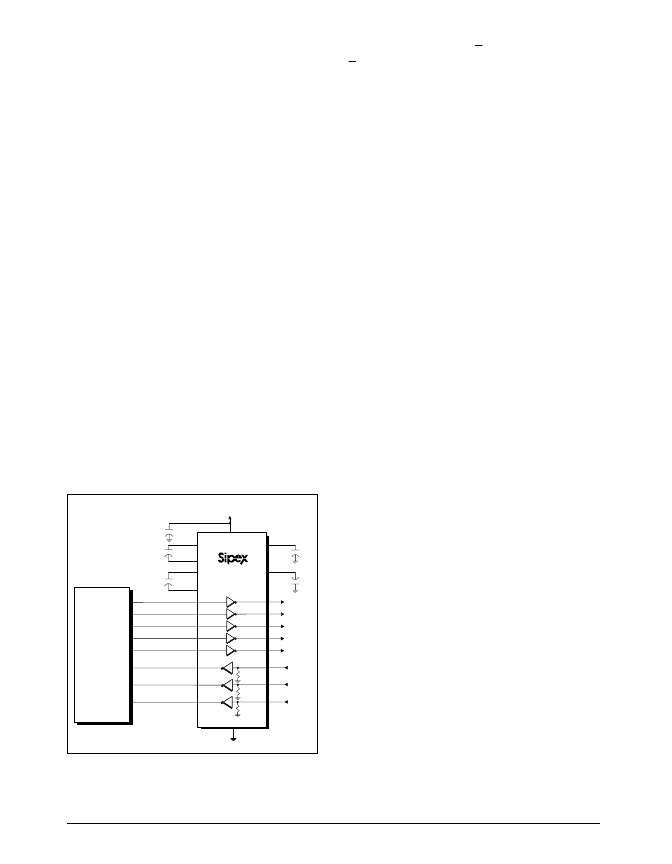- 您現(xiàn)在的位置:買賣IC網(wǎng) > PDF目錄372179 > SP3249EEA 5V High-Speed RS-232 Transceivers with 0.1uF Capacitors PDF資料下載
參數(shù)資料
| 型號(hào): | SP3249EEA |
| 元件分類: | RS-232 |
| 英文描述: | 5V High-Speed RS-232 Transceivers with 0.1uF Capacitors |
| 中文描述: | 5V的高速RS - 232收發(fā)器與0.1uF電容 |
| 文件頁(yè)數(shù): | 6/14頁(yè) |
| 文件大小: | 128K |
| 代理商: | SP3249EEA |
第1頁(yè)第2頁(yè)第3頁(yè)第4頁(yè)第5頁(yè)當(dāng)前第6頁(yè)第7頁(yè)第8頁(yè)第9頁(yè)第10頁(yè)第11頁(yè)第12頁(yè)第13頁(yè)第14頁(yè)

Rev.4/08/02
SP3249E Intelligent +3.0V to +5.5V RS-232 Transceivers
6
Copyright 2002 Sipex Corporation
DESCRIPTION
The SP3249E
device
meets the EIA/TIA-232 and
ITU-T V.28/V.24 communication protocols and
can be implemented in battery-powered, por-
table, or hand-held applications such as
notebook or palmtop computers. The SP3249E
device features Sipex's proprietary and patented
(U.S. #5,306,954) on-board charge pump
circuitry that generates
±
5.5V RS-232 voltage
levels from a single +3.0V to +5.5V power
supply. The SP3249E device can operate at
a data rate of 250kbps fully loaded.
The SP3249E is a 5-driver/3-receiver device,
ideal for portable or hand-held applications.
The SP3249E device is an ideal choice for
power sensitive designs.
THEORY OF OPERATION
The SP3249E device is made up of three basic
circuit blocks: 1. Drivers, 2. Receivers, and
3. the Sipex proprietary charge pump.
Drivers
The drivers are inverting level transmitters that
convert TTL or CMOS logic levels to 5.0V EIA/
TIA-232 levels with an inverted sense relative to
the input logic levels. Typically, the RS-232
output voltage swing is +5.4V with no load and
+5V minimum fully loaded. The driver outputs
are protected against infinite short-circuits to
ground without degradation in reliability. These
drivers comply with the EIA-TIA-232F and all
previous RS-232 versions. Unused driver inputs
should be connected to GND or V
CC
.
The drivers can guarantee a data rate of 250kbps
fully loaded with 3k
in parallel with 1000pF,
ensuring compatibility with PC-to-PC commu-
nication software.
The slew rate of the driver output is internally
limited to a maximum of 30V/
μ
s in order to
meet the EIA standards (EIA RS-232D 2.1.7,
Paragraph 5). The transition of the loaded
output from HIGH to LOW also meets the
monotonicity requirements of the standard.
Figure 7
shows a loopback test circuit used to test
the RS-232 Drivers. Figure 8
shows the test
results of the loopback circuit with all five driv-
ers active at 120kbps with typical RS-232 loads
in parallel with 1000pF capacitors. Figure 6
shows
the test results where one driver was active at
250kbps and all five drivers loaded with an RS-
232 receiver in parallel with a 1000pF capacitor.
A solid RS-232 data transmission rate of 120kbps
provides compatibility with many designs in
personal computer peripherals and LAN appli-
cations.
Receivers
The receivers convert
±
5.0V EIA/TIA-232
levels to TTL or CMOS logic output levels.
Since receiver input is usually from a transmission
line where long cable lengths and system
interference can degrade the signal, the inputs
have a typical hysteresis margin of 500mV. This
ensures that the receiver is virtually immune to
noisy transmission lines. Should an input be left
unconnected, an internal 5k
pulldown resistor
to ground will commit the output of the receiver
to a HIGH state.
Figure 6. Interface Circuitry Controlled by
Microprocessor Supervisory Circuit
SP3249E
3
1
4
GND
C1+
C1-
C2+
C2-
V+
V-
V
CC
0.1
μ
F
0.1
μ
F
0.1
μ
F
+
C2
C5
C1
+
+
C3
C4
+
+
0.1
μ
F
0.1
μ
F
V
CC
2
5k
5k
5k
24
23
22
21
20
18
5
6
7
8
9
11
RS-232
OUTPUTS
RS-232
INPUTS
T
1
IN
R
1
OUT
R
1
IN
T
2
OUT
T
2
IN
T
3
IN
T
3
OUT
T
1
OUT
R
2
IN
R
3
IN
R
2
OUT
R
3
OUT
UART
or
Serial
μ
C
TxD
RTS
DTR
RxD
CTS
DSR
DCD
RI
19
17
10
12
T
4
OUT
T
4
IN
T
5
IN
T
5
OUT
13
15
14
16
相關(guān)PDF資料 |
PDF描述 |
|---|---|
| SP3249EEY | 5V High-Speed RS-232 Transceivers with 0.1uF Capacitors |
| SP3249 | 5V High-Speed RS-232 Transceivers with 0.1uF Capacitors |
| SP3239E | 5V High-Speed RS-232 Transceivers with 0.1uF Capacitors |
| SP3281EBCA | 5V High-Speed RS-232 Transceivers with 0.1uF Capacitors |
| SP3281EB | 5V High-Speed RS-232 Transceivers with 0.1uF Capacitors |
相關(guān)代理商/技術(shù)參數(shù) |
參數(shù)描述 |
|---|---|
| SP3249EEY | 制造商:SIPEX 制造商全稱:Sipex Corporation 功能描述:Intelligent +3.0V to +5.5V RS-232 Transceivers |
| SP3249EEY-L | 功能描述:RS-232接口集成電路 Intel. +3V to +5.5V RS-232 RoHS:否 制造商:Exar 數(shù)據(jù)速率:52 Mbps 工作電源電壓:5 V 電源電流:300 mA 工作溫度范圍:- 40 C to + 85 C 安裝風(fēng)格:SMD/SMT 封裝 / 箱體:LQFP-100 封裝: |
| SP3249EEY-L/TR | 功能描述:RS-232接口集成電路 Intel. +3V to +5.5V RS-232 RoHS:否 制造商:Exar 數(shù)據(jù)速率:52 Mbps 工作電源電壓:5 V 電源電流:300 mA 工作溫度范圍:- 40 C to + 85 C 安裝風(fēng)格:SMD/SMT 封裝 / 箱體:LQFP-100 封裝: |
| SP3-2-50 | 制造商:RHOMBUS-IND 制造商全稱:Rhombus Industries Inc. 功能描述:SP3 Series Mini-SIP Passive Delay Modules |
| SP3-2-55 | 制造商:RHOMBUS-IND 制造商全稱:Rhombus Industries Inc. 功能描述:SP3 Series Mini-SIP Passive Delay Modules |
發(fā)布緊急采購(gòu),3分鐘左右您將得到回復(fù)。